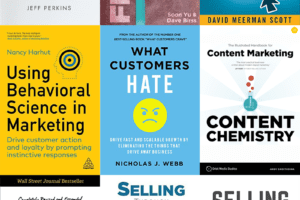Episode 56 of Yes, and Marketing
Professor, author, and consultant, Tim is known as an international expert on brand strategy. At Kellogg, he’s a frequent winner of Professor of the Year and famous for creating a highly anticipated annual review of Super Bowl ads. In this episode, he covers the winners and losers in this year’s Super Bowl spots and breaks down how branding has evolved over the last 20 years, the future of brand strategy, and what aspects of marketing can—and can’t—be taught.
Tap through the chapters in the audio above or read on for our favorite highlights and top takeaways from the conversation.
Guest-at-a-Glance
???? Name: Tim Calkins
???? What he does: Professor of Marketing at Northwestern’s Kellogg School of Management. Consultant, speaker, and author of How to Wash a Chicken: Mastering the Business Presentation.
????️ Find Tim on the web: LinkedIn | Tim Calkins website | How to Wash a Chicken
???? Get smart: “If you define your marketing success by clicks on Facebook, you’re not gonna build a brilliant brand in the long run.”
Top Takeaways
Marketing is a team sport ????
Tim compares his time as a consultant with his time as a brand marketer at Kraft. “In consulting, you can be pretty successful in consulting on your own,” he says. “It’s just like when you’re in school: if you want to get a good grade, you can work hard and study a lot and you’ll get a good grade.”
At Kraft, however—or on the marketing team of any organization—your success depends on other people, in addition to your own work. “You can work as hard as you want, but if your salesperson doesn’t come through for you, it’s not gonna go well and the project is gonna fall apart,” Tim explains. “You have to find a way to really engage the organization and work with people and communicate.”
A case study in branding: Peloton ????
As technology and targeting move marketing from giant, universal brands to smaller, more niche names, Peloton is one brand that Tim says is doing all the right things. “What they are doing so well at the moment,” he explains, “is they are creating this community of enthusiasts. And to build a great brand today, I think you really need that group of enthusiasts. You need the people who really, really are involved with your brand and are engaged.”
One unique feature? In addition to creating a base of fanatics who are notoriously vocal about the brand, Peloton has also fostered powerful instructor brands. “People are loyal to these instructors, and they can talk about the instructors that they follow,” Tim says. He points out that aspect as something to keep an eye on:
“You’ve got this funky mix of the Peloton brand and the instructor brands that’s gonna be really fun to watch. Which of those brands has more enduring power in terms of negotiating? It’s like a sports franchise with the athletes. The athletes are brands—powerful brands— and the franchise is powerful and they work together, and yet there is a tension there.”
Episode Highlights
One hard truth from the corporate world ????
“One lesson is around the role of financials and the importance of connecting what you’re doing back to the results. In a company like Kraft, and I think most companies at the end of the day, those results really do matter. You can be as elegant as you want on the marketing stuff you’re doing and you can create wonderful social media campaigns, but people wanna see the results. And if you don’t get the results, you’re probably getting fired.”
The 3 ingredients of a successful Super Bowl ad ????
“One, is you’ve gotta find a way to break through the clutter of the Super Bowl. It’s gotta be different. It’s gotta be unique. It’s gotta get people’s attention. That’s one thing it has to do. But the second thing it has to do is, it’s gotta be linked to the product. And very often, this is where so many Super Bowl ads really miss because it’s a super creative, funny piece of advertising, but there’s just no link to the brand. And then you remember the ad, but you don’t remember the brand. The third thing though, is you really need that benefit to come across. Ultimately, you’ve got to give people a reason to buy the product.”
What can (and can’t) be taught at business school
“What I try to teach people at Kellogg is a way of thinking and a set of principles and some enduring truths and techniques and ways of looking at the world. You try to teach people what makes for a great brand: How do you think about building a great brand, and what are the principles that drive branding? What do we really know to be true?
But what I spend less time on in my classes are the details of, ‘How do you go buy advertising on TikTok?’ because one of the challenges there is that change is so fast. You figure out how to buy advertising on TikToK today, but then they go change their algorithm and everything we were doing in two weeks can just vanish. Same thing if you think about buying advertising on Facebook. That’s a little tougher to teach people because it’s not an enduring set of skills.”
The limitations of measurements and data
“The risk is that we get so enamored with that data that that’s where we end up spending all of our time and focus and money. And the problem is, that a lot of the things that really have value are not easily measured. So you can measure conversion on Facebook, but is that really measuring brand enthusiasm? Is that really measuring loyalty? And the answer is, I don’t think it is.”
Marketing in the time of COVID
“All throughout the pandemic, the thing that’s been pretty consistent is there’s just been terrible, terrible communication and terrible marketing. And I think it’s sad because pretty early in the pandemic, it was pretty clear what we were supposed to do: lay low, wear masks, social distance.
But the problem was, I don’t think that message ever got to people in a way that resonated. The public health officials and other people involved, they never managed to connect the actions they were hoping people would take to the benefits. And as a result, people said, ‘Wear a mask,’ and then the public said, ‘Well, but why would I wear a mask? Wearing a mask is not natural to me, it seems unfamiliar, it seems unpleasant. I don’t think so.’ Whereas if we had had great marketing behind that, I think we would have gotten much better adoption of some of these behaviors that we’re seeing.”
Top Quotes
????️ Tim:
“Your success is only partially due to what you do. A lot of it is due to how do you work with everybody else in the organization.”
“If you define your marketing success by clicks on Facebook, you’re just not gonna build a brilliant brand in the long run.”
“The brands that seem to have a lot of momentum are these very precisely positioned, targeted brands that really appeal to a smaller group of people.”
“As the world gets more complicated and more challenging to navigate, I think brands can be a real touch point for people.”
Learn More
Tim used Philip Kotler’s definition of marketing on the show: “It’s the process of connecting products, services, and ideas to customers’ needs and wants.” Read more of Philip’s thoughts on marketing.
The Super Bowl Ads ????
- Indeed’s “The Rising“
- Tim’s take: “The more times you watch that spot, the more compelling it becomes. It starts with the woman clearly unemployed and the man very clearly looking for the next thing, and it’s quiet. But by the end of it, it’s this wonderful story of achievement and success. And all throughout, what you see is people using Indeed to further their journey and make that happen. That spot is inspirational and it’s emotional and it’s all about the product, but it’s really about the benefit.”
- Squarespace’s “5 to 9 by Dolly Parton” (and the extended version)
- Tim’s take: “Really nice concept, great celebrity. Everybody loves Dolly Parton. Hard to miss on that one, and yet the spot didn’t really work because it was a lot of people dancing around, but you just didn’t link it back to the product. So I think they missed on that one. …They had a long version of that spot, which was a 60 second spot that actually worked pretty well. When they shortened it up, though, they lost the linkage to the product and this spot just didn’t work like it could have.”
- Google’s “Parisian Love“
- Tim’s take: “What’s nice about it is that it is very different. It’s very unique. It also very much conveys the benefit. The whole ad is really just a product demonstration, and it shows you exactly what you can do on Google. The branding is rock solid. It’s charming, it’s endearing. It’s a beautiful, beautiful Super Bowl ad.”



